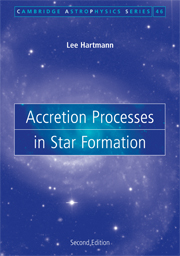Book contents
- Frontmatter
- Contents
- Preface to the first edition
- Preface to the second edition
- Acknowledgments
- 1 Overview
- 2 Beginnings: molecular clouds
- 3 Initial conditions for protostellar collapse
- 4 Protostellar cloud collapse
- 5 Protostellar collapse: observations vs. theory
- 6 Binaries, clusters, and the IMF
- 7 Disk accretion
- 8 The disks of pre-main-sequence stars
- 9 The FU Orionis objects
- 10 Disk winds, jets, and magnetospheric accretion
- 11 Disk accretion and early stellar evolution
- 12 Disk evolution and planet formation
- Appendix 1 Basic hydrodynamic and MHD equations
- Appendix 2 Jeans masses and fragmentation
- Appendix 3 Basic radiative transfer
- List of symbols
- Bibliography
- Index
12 - Disk evolution and planet formation
Published online by Cambridge University Press: 30 October 2009
- Frontmatter
- Contents
- Preface to the first edition
- Preface to the second edition
- Acknowledgments
- 1 Overview
- 2 Beginnings: molecular clouds
- 3 Initial conditions for protostellar collapse
- 4 Protostellar cloud collapse
- 5 Protostellar collapse: observations vs. theory
- 6 Binaries, clusters, and the IMF
- 7 Disk accretion
- 8 The disks of pre-main-sequence stars
- 9 The FU Orionis objects
- 10 Disk winds, jets, and magnetospheric accretion
- 11 Disk accretion and early stellar evolution
- 12 Disk evolution and planet formation
- Appendix 1 Basic hydrodynamic and MHD equations
- Appendix 2 Jeans masses and fragmentation
- Appendix 3 Basic radiative transfer
- List of symbols
- Bibliography
- Index
Summary
The discovery of many extrasolar planetary systems over the last decade, most with properties considerably different from those of the solar system, has revolutionized thinking about the processes of planet formation. An entire book could be devoted to the vast literature that has arisen on this complex topic. The aim of the present chapter is limited to outlining a few relevant astrophysical constraints on disk evolution and to sketch some of their potential implications for planet formation.
Our current lack of understanding of angular momentum transport in protoplanetary disks is a major obstacle to understanding how planets form. The presence or absence of a dead zone (§7.6) can strongly affect dust coagulation/planetesimal growth rates by piling up material over time; the activation or lack of same of the MRI will affect disk turbulence, which in turn affects the rates at which dust settles and grows in the disk. Astrophysical clues to these processes are meager at present, though there is evidence that settling and growth of small dust particles is at least somewhat limited by turbulence.
Dust disks within a few to 20 AU of the central star tend to “clear” (i.e., become undetectable in infrared excesses) on timescales of a few Myr. Individual systems exhibit a wide range of clearing timescales; some low-mass stars of ages ∼ 1 Myr have no detectable disks, while of order 5% of stars of ages ∼ 10 Myr exhibit substantial disk emission.
- Type
- Chapter
- Information
- Accretion Processes in Star Formation , pp. 268 - 291Publisher: Cambridge University PressPrint publication year: 2008



